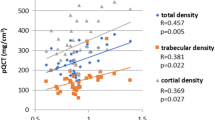Abstract
Sarcoidosis is a multisystem granulomatous disease of unknown etiology. Almost any organs of the body, but mostly the lungs, are involved. Bone mineral density (BMD) can be affected directly or indirectly in chronic granulomatous systemic diseases such as sarcoidosis. The aim of our study was to evaluate BMD in premenopausal and postmenopausal sarcoidosis patients with or without prednisone treatment and to compare their BMD values with those of a control group having the same menopausal status. Thirty-five premenopausal women (18 untreated, 8 treated, and 9 controls) and 21 postmenopausal women (5 untreated, 5 treated, and 11 controls) were included in the study. All of the patients had a histologically proven diagnosis and were being followed-up at the Sarcoidosis Outpatient Clinic of our unit. BMD of the lumbar (L) spine and femoral neck was measured by dual-energy absorptiometry (DEXA). The subgroups of premenopausals and postmenopausals were compared separately. Comparison among the groups was performed by using analysis of variance. Age, duration of the disease, and body mass index were comparable in treated, untreated, and control subgroups of the pre- and postmenopausal groups, and the subgroups of postmenopausals had comparable durations since menopause. For premenopausals, BMD values at L1–4 were not significantly different among the subgroups (0.920 ± 0.08 g/cm2, 0.801 ± 0.09 g/cm2, and 0.910 ± 0.05 g/cm2, for untreated, treated, and controls, respectively). However, the BMD value at the femoral neck in treated patients (0.921 ± 0.1 g/cm2) was significantly lower than the values in untreated patients (1.080 ± 0.2 g/cm2; P ≪ 0.01) and in controls (1.028 ± 0.17 g/cm2; P ≪ 0.05). For postmenopausals, the BMD value at L1–4 in controls (1.019 ± 0.07 g/cm2) was significantly higher than the values in untreated patients (0.783 ± 0.01 g/cm2) and in treated patients (0.751 ± 0.08 g/cm2; P ≪ 0.001 for both). The BMD value at the femoral neck in controls (0.890 ± 0.1 g/cm2) was higher than the values in untreated patients (0.745 ± 0.08 g/cm2) and treated patients (0.747 ± 0.1 g/cm2), but the difference was not statistically significant (P = 0.06). We concluded that sarcoidosis patients, especially postmenopausal patients with corticosteroid treatment, may have an increased risk of bone mineral loss. Large-scale studies are warranted in order to delineate the exact roles of the disease itself, menopausal status, and corticosteroid treatment in this bone mineral loss.
Similar content being viewed by others
Author information
Authors and Affiliations
Corresponding author
About this article
Cite this article
Sipahi, S., Tuzun, S., Ozaras, R. et al. Bone mineral density in women with sarcoidosis. J Bone Miner Metab 22, 48–52 (2004). https://doi.org/10.1007/s00774-003-0448-0
Received:
Accepted:
Issue Date:
DOI: https://doi.org/10.1007/s00774-003-0448-0




